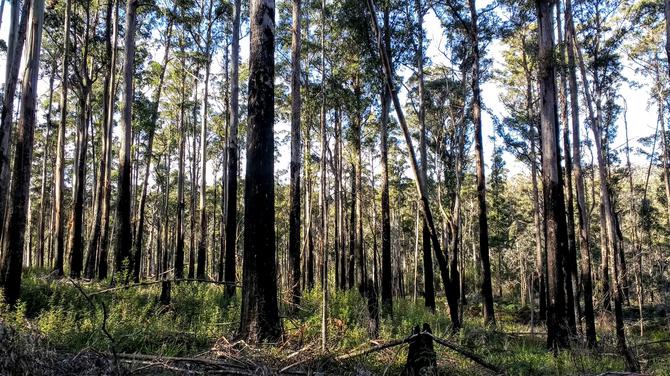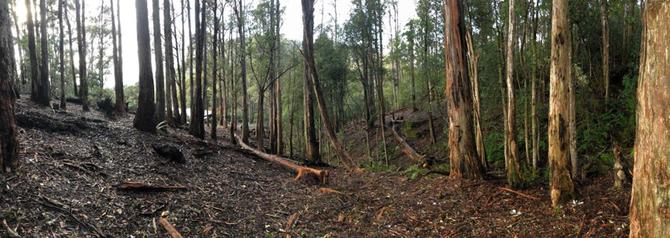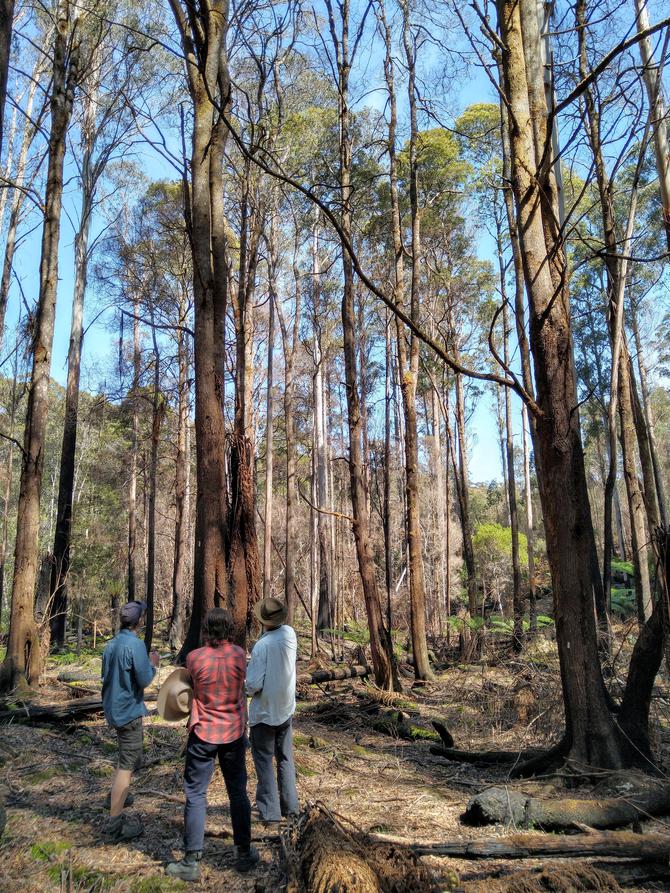Tasmanian giant eucalypt forests, or more precisely, mature tall wet Eucalyptus forests (TWEF), are among the most unusual and important forests on Earth.
Old growth TWEF store more carbon than any other forests, and are important to the timber industry. They
are of high conservation value and form picturesque backdrops to many
landscapes, including those surrounding the city of Hobart.
The relationship between TWEF and fire is complicated. Fire is an integral part of the life cycle of TWEF, as
eucalypts require fire to regenerate. TWEF
share the same ecological and
climatic niche as
rainforests (rainforest trees often occupy TWEF understoreys). Accordingly, they are typically not dry
enough to burn, so bushfire occur infrequently (> 50 years). The fire risk to forests is strongly
influenced by fire weather: under extreme fire weather condition all forests ages will burn severely. Concerningly, there is evidence that the incidence of
lightning-ignited fire increasing due to climate change.
Harvesting of these forests has been a topic of much
debate. Regeneration of logged TWEF uses intense fires to mimic bushfires that initiate natural regeneration. This involves
clearing all trees, burning debris, and sowing seeds of eucalypt trees native to
the area. This so called
‘clearfell-burn-sow’ practice has proved controversial, especially when it
relates to fire danger and biodiversity.
Fire is an integral part of the life cycle of tall wet Eucalyptus forests. Picture: James Furlaud
Some have argued that
compared with mature forest, recently clearfelled TWEF have less fuel moisture,
with dense canopies of regrowth that are
close to the ground, with a greater risk of severe fire. In forests that are killed by canopy fire, and rely the trees on seed
to regenerate, this can lead to landscape-level ecosystem collapse. Others have argued that the dense regeneration
post-clearfell renders the forest floor moister and fuels less hazardous, and that clearfelled stands are less likely to burn due to low fuel loads. Indeed, the only consistent research theme to
emerge from the past few decades is that there is no scientific consensus on
the effects of clearfelling on fire risk.
Most studies on forest-fire risk following logging have been based on interpretation of remote sensing
data (i.e. satellite data or aerial photography) with very limited field
checking and empirical observations, particularly in Tasmanian forests. To fill this gap, we developed the first
study, published last week, that estimated fire risk in Tasmanian TWEF
across a range of ages.
In what is known as a chronosequence
(a series of permanent, long-term ecological research sites across four
different age classes of forest), we measured fuel load (the amount of burnable
material in the forest), fuel structure (how well connected that material is),
and measured understorey microclimate (which affects how easily the forest
ignites). We then used simple fire behaviour models to assess the fire risk in
each of the four age classes of the forest.
What we found was that
young regenerating forests, which were full of saplings, had a dry microclimate
and a low canopy stature that made destructive crown fires much more likely,
whereas older forests had a lush, moist, rainforest understorey and a tall
canopy. This meant that fires in older forests, when they occurred, were more
likely to remain in the understorey. However, our results also indicated that, if
fire weather becomes extreme enough to allow for even the lush rainforest understorey
to ignite, crown fires become more likely than understorey fires, even in old
growth forests. Therefore, under dangerous
fire weather the difference in fire risk among forest age classes is minimised,
creating the potential for megafires, as occurred in 2019-20.
Understorey management could play an important role in mitigating fire risk. Picture: John Fisher
A similar study we published
in April indicated that climate change is likely to increase fire risk in
Tasmanian TWEF. Further climate change will increase
dangerous fire weather in Tasmania, and will likely make the kind of drought
that allows rainforest to ignite more frequent. Both of our studies underscored
that, under such extreme fire weather, dense understoreys including rainforest
trees can act as ‘ladder fuels’ when they combust, carrying fire into the
canopy. So, management (including
removal) of these understorey trees could be critical in managing fire risk in
Tasmanian TWEF.
Our study offers some
interesting insights into the sustainable management of TWEF. When young forests
burn before they are old enough to produce seeds, the result is ecologically catastrophic. Our results suggest that concentrated
clearfelling in small areas could potentially increase landscape-scale
flammability and lead to loss forests without restoration programs.
Plantations are often
touted as an alternative to native forestry. However, because plantations are
densely packed with trees and have heavy fuel loads, they are just as vulnerable to fire damage as young stands regenerating
after clearfelling.
Our research does not
necessarily mean that all native forestry is bad, and that there is no place
for forest management in sustaining forests as the climate warms. Management
techniques focusing on thinning and removal of forest understorey are well-developed
in North America to reduce fire risk. There is increasing interest in applying
these principles to Australian native forests, which could lead to the
replacement of traditional clearfell-burn-sow silviculture with partial cutting
and thinning to build resilience in native forests. An important social
dimension of these approaches are creating employment
in the forestry sector while restoring important ecological processes, building
bushfire-fighting capacity in rural communities, and possibly creating pathways
for Indigenous communities to participate in forest management.
Studying low-severity fire in a Tasmanian wet eucalypt forest. Picture: James Furlaud
Already, the Tasmanian
forest industry has taken in important first step in implementing new
management techniques, developing and implementing variable retention harvesting, which leaves ‘islands’ of unlogged forests.
This technique helps maintain a ‘multi-aged’ stand structure and retaining some
of the moist understorey. Further, techniques involving thinning of regrowth
forests to improve productivioty and fire resilience are now implemented in
parts of the state. Currently the Fire Centre Research Hub at the University of
Tasmania is working with the City of Hobart on a project trialling the use of
understorey thinning in TWEF on the outskirts of Hobart to reduce fuel loads. However
more research and evaluation needs to be done to move away from clearfelling,
and evaluate understory thinning to manage fire hazards.
Our paper is not the
last word in the complex topic. More research, including trials and evaluation involving
targeted partial logging, thinning and burning are required to find sustainable
ways to build resilience into Tasmanian forests as they are further stressed by
climate change.
This series of
research papers investigating the fire regime of TWEF was published in the
journal Forest Ecology and Management and the Journal of Ecology.
Authors: Dr James Furlaud, Dr Grant Williamson, and Prof David Bowman.



